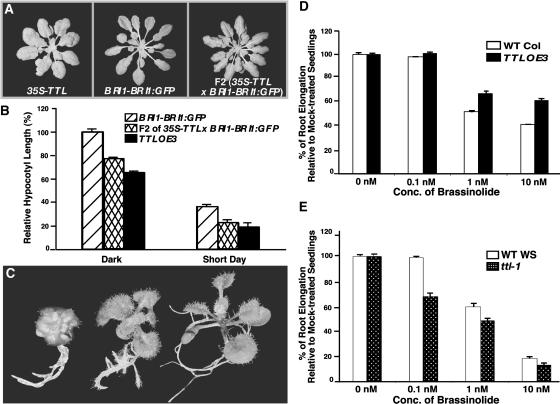Figure 7.
TTL Modulates BR-Mediated Growth Response.
(A) Overexpression of the TTL gene suppresses the BRI1 overexpression phenotype. Shown (from left to right) are a 35S-TTL transgenic plant, a BRI1-BRI1:GFP transgenic line, and a F2 plant homozygous for both the 35S-TTL and BRI1-BRI1:GFP transgenes.
(B) Quantitative analysis of the hypocotyl growth of the 5-d-old transgenic Arabidopsis seedlings grown in the dark or under the 8-h-light/16-h-dark growth condition. Hypocotyl growth is expressed as a percentage of the hypocotyl length of the dark-grown seedlings of the BRI1-overexpressing transgenic line, and each data point represents the average of ∼30 seedlings.
(C) The ttl mutants display a brassinazole-resistant phenotype. Shown (from left to right) are a wild-type seedling, a ttl-1 mutant, and a BRI1-BRI1:GFP transgenic plant grown on 1 μM brassinazole-containing medium.
(D) and (E) Quantitative analysis of BR sensitivity of the TTL-overexpressing plants (D) and the ttl-1 mutants (E). Seedlings were germinated and grown on medium containing increasing concentrations of brassinolide. Root elongation was measured 7 d after germination. Each data point represents the average root elongation of ∼50 seedlings. Inhibition of root growth by brassinolide is expressed as a percentage of the root elongation of the wild-type controls grown on medium containing the same volume of 80% (v/v) ethanol used to dilute brassinolide from a 2 mM stock solution. Error bar denotes standard error.

